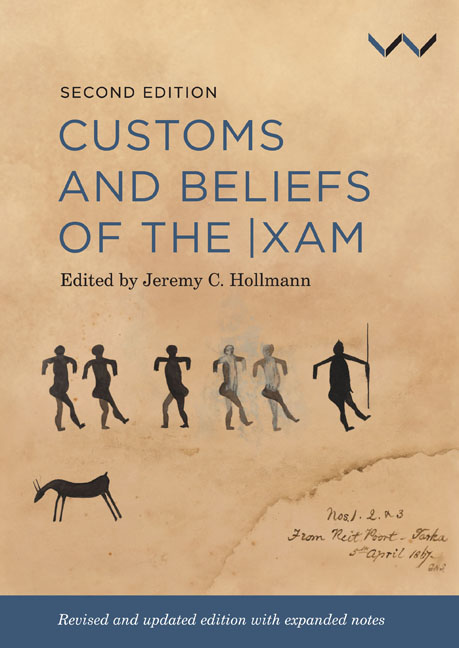Book contents
- Frontmatter
- Dedication
- Contents
- Acknowledgements
- Foreword To The Second Edition
- Foreword To The First Edition
- Introduction
- Contributors
- The |Xam Language
- The People In The Notebooks
- Part 1 Baboons
- Part 2 The Lion
- Part 3 Game Animals
- Part 4 Omens, Windmaking, Clouds
- Part 5 Rain
- Part 6 Rainmaking
- Part 7 Sorcerers
- Part 8 More About Sorcerers and Charms
- Part 9 Special Speech of Animals and Moon
- Appendix 1 |Xam Grammar
- Appendix 2 Summary of The Narratives
- References
- Index
Part 9 - Special Speech of Animals and Moon
Published online by Cambridge University Press: 24 November 2023
- Frontmatter
- Dedication
- Contents
- Acknowledgements
- Foreword To The Second Edition
- Foreword To The First Edition
- Introduction
- Contributors
- The |Xam Language
- The People In The Notebooks
- Part 1 Baboons
- Part 2 The Lion
- Part 3 Game Animals
- Part 4 Omens, Windmaking, Clouds
- Part 5 Rain
- Part 6 Rainmaking
- Part 7 Sorcerers
- Part 8 More About Sorcerers and Charms
- Part 9 Special Speech of Animals and Moon
- Appendix 1 |Xam Grammar
- Appendix 2 Summary of The Narratives
- References
- Index
Summary
In Parts 1 to 8, Dorothea Bleek selected and arranged narratives about |xɑm customs and beliefs; in Part 9, the focus is on the |xɑm language itself and how the narrators imagined it was spoken by animals.
Six of these narratives were taken down by Wilhelm Bleek, who was especially interested in this ‘special speech’:
A most curious feature in Bushman folklore is formed by the speeches of various animals, recited in modes of pronouncing Bushman, said to be peculiar to the animals in whose mouths they are placed. It is a remarkable attempt to imitate the shape or position of the mouth of the kind of animal to be represented. Among the Bushman sounds which are hereby affected, and often entirely commuted, are principally the clicks.
(Bleek 1875: 6)Having observed that |xɑm speakers imagined how the clicks would sound when produced by the mouth of an animal, Bleek described how he and Lucy Lloyd put this speech down in writing:
It need not be said that, if it be by no means easy to write Bushman itself, the difficulty of taking down these animal speeches is by far greater, and before any attempt could be made to translate them into English or Dutch, they had first to be rendered into ordinary Bushman by our informants.
(Bleek 1875: 6)When dictating to Bleek or Lloyd, the |xɑm narrators first spoke in the particular animal's peculiar speech, before going back and translating it into ‘human’ language. Bleek believed that animal clicks were evidence of the probable existence of many more click sounds in the indigenous click languages:
The presence of these abnormal clicks in the different kinds of speech, points to the possibility, nay, even to the probability, of the former presence of many more clicks in the Bushman language than the five which are now to be found there.
(Bleek 1875: 6)The ‘probability’ that the number of click sounds was decreasing fitted in with Bleek's ideas about the evolution of language, as he (incorrectly) believed that |xɑm belonged to the most ‘ancient’ class of languages.
- Type
- Chapter
- Information
- Customs and Beliefs of the |xam , pp. 443 - 504Publisher: Wits University PressPrint publication year: 2022



